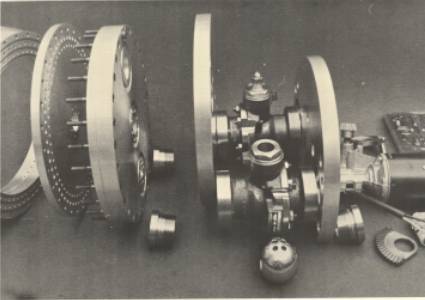Apology OTRAG or how rockets explode

We continue to talk about the modular "big stupid" booster OTRAG. In the second part, we, with figures in our hands, proved that the reliability of a large bundle of rocket blocks can be ensured by adding redundant blocks. The following objection, which has been repeatedly raised in the comments, is a scenario of an avalanche-like destruction of a package when one unit fails. A terrible picture is drawn, when the failure of one block leads to an explosion, the fragments pierce the neighboring blocks, which also explode, and the entire launch vehicle flies into pieces. Therefore, today we will talk about the physics of the explosion, about what could explode in a rocket, and how it will do it.
Introduction
First, let's take a look at the well-known compilation of launch vehicle accidents:
')
Please note that the explosions are not the main type of accident, and the most impressive "women" occurs when the rocket hits the ground or after being destroyed in flight.
Explosion physics
What is an "explosion" in terms of physics? Curiously, there is no simple answer. Chemical explosives, an atomic bomb, a steam boiler, a volcano, a star, and even a fall of a meteorite can be accompanied by an explosion. Despite completely different principles, all these explosions are accompanied by the release of a large amount of energy in a small volume in a short period of time . If an explosion is associated with the burning of a substance, then in the case when the burning front moves faster than the speed of sound, this process is called detonation. To create a supersonic front may require special devices - detonators. For example, TNT (trinitrotoluene), if ignited, will burn calmly. But if a detonator is inserted into the TNT block, it can already initiate an explosion. Powder-type substances cannot detonate, they “only” burn quickly. And if the burning takes place in a closed volume, the pressure can rise so quickly that it can effectively throw a bullet or projectile out of the barrel.
What can explode in a rocket?
Emergency blasting charges . In fact, this is the only element that can detonate in a launch vehicle. So that the unguided rocket does not cause harm, it is undermined. Here, for example, the location of the cord charges, which were placed on the "Space Shuttles":

Long charges of explosives had to quickly and effectively destroy the external fuel tank and solid fuel boosters. For example, in the Challenger disaster, boosters survived the destruction of the shuttle and fuel tank, and were undermined by these charges a few seconds later.
In the Soviet / Russian tradition, when the cosmodrome is far from densely populated places, an emergency rocket simply turns off the engines. In this case, there are no explosives on the rocket at all.
Destruction of the solid accelerator . Solid fuel boosters, as is known, cannot be turned off after ignition. And their thrust is governed by the profile of the hole in the solid fuel block:

If there is a crack in the fuel checker, for example, then its surface will also start to burn, sharply increasing the pressure. If the crack is large, a surge of pressure can destroy the accelerator, causing a very impressive explosion:
The destruction of the engine . A combustion chamber with a regenerative cooling system, nozzle heads, pipes and connections — any failure here can lead to engine damage. For example, the injector head in flight of the Dragon CRS-2 in 2012 collapsed:
The explosion was quite powerful - you can see on the video a broken engine fairing. But SpaceX was lucky - there were no fragments that would damage the neighboring engines, Dragon successfully flew to the ISS.
Destruction of the turbopump assembly . A turbopump assembly is a high-loaded turbine that rotates at a tremendous speed and pumps tens and hundreds of kilograms of fuel components per second:

It may collapse due to a material defect (in aviation there are cases of turbine destruction when a defect was laid at the titanium casting stage). If the rotor strikes the wall, then the heat released from the friction will sharply raise the pressure and cause an explosion. A foreign object from the fuel tank may also enter the THA, which, again, will lead to an explosion. The destruction of THA is dangerous because a very fast rotating turbine can fly apart into heavy and dangerous fragments. Presumably, the destruction of the turbopump led to the Antares Orb-3 accident in the fall of 2014. The results of the investigation have not yet been announced, but a change in the color of the flame shortly before the explosion and the serious destruction of the tail of the rocket make this version very likely.
Destruction of tanks and pipelines . The least likely and least explosive option. A small leak can go unnoticed, a medium leak can cause a fire, and you need to specially invent a scenario that would lead to an explosion. Something like the destruction of the fuel pipeline, which would lead to the formation of a mixture of fuel and atmospheric air in the engine compartment and the subsequent explosion of this mixture.
What could explode in Otrag?
We recall the design of the OTRAG rocket block:

Tanks of fuel, oxidizer and pressurized gas cannot explode. More precisely, the simplest crimping with a little increased pressure lets you know if this particular block can withstand the working pressure. If the unlikely event of depressurization does occur, the leakage of components without conditions for an explosion will begin. The space between the blocks in the conditions of atmospheric blowing in flight will not allow the formation of components for a volumetric explosion. Even a catastrophic loss of tightness in the case of, for example, failure of the joint anchorages, can not lead to the formation of fragments dangerous for the neighboring blocks.
The turbo pump unit cannot collapse in the OTRAG simply because it is not there. Fuel components are supplied by pressurized gas and do not use additional pumps.
As for the combustion chamber and the engine, they are arranged as simply as possible:

Control unit Two pipes are visible (oxidizer and fuel), a valve actuator motor and a rod connecting the valves to simultaneously change the component feed.

On the left - the unit injectors. The ball in the foreground, obviously, shows that the valve supply components is an ordinary ball valve

The combustion chamber. Cooling walls ablative

Engine assembly at the booth
Curiously, in the middle of the zero years, Lutz Kaiser visited the company Armadillo Aerospace and presented them with a copy of the modern version of the injector:

Control unit

Top view, well visible ball valves

Nozzle block
Such a structure operating in conditions of 40 atm cannot explode. There is no regenerative cooling system that could burn through, there are no complicated pipelines, and the nozzle heads, drilled in metal, have a visible margin of safety. In general, the engine with its simplicity resembles plumbing - two ball valves and a shower watering can.
Well, let's give way to paranoia and try to imagine what will happen in the event of a catastrophic failure of the structure? It's funny, but on YouTube there are videos of similar failures - some Japanese company tested rocket engines. It is more difficult than OTRAG, and, nevertheless, in the worst case, the engine just flies away. If this had happened in flight, the engine that had flown away could not have damaged the neighboring blocks.
The final argument. 40 atmospheres is a little by modern standards. There are 20 atmospheres in a domestic gas cylinder, only half the size of the OTRAG, and this does not prevent them from being widely used, despite the fact that the quality of their service is far from cosmic. Scuba diving cylinders work with 200 and 300 atmospheres, and in spite of this, they are widely distributed and are used successfully.
Conclusion
I hope that the arguments presented are sufficient to recognize the scenario of an avalanche-like destruction of the blocks as extremely unlikely. From OTRAG it could well turn out a good and reliable rocket.
List of used sources
Source: https://habr.com/ru/post/365309/
All Articles